β-Si3N4 Microcrystals Prepared by Carbothermal Reduction-Nitridation of Quartz
Abstract
:1. Introduction
2. Experimental
2.1. Materials
2.2. Methods
2.3. Characterization
3. Results and Discussion
3.1. Influence of Synthetic Schedule on the Phase Composition and Morphology of Products
3.1.1. Influence of Temperature on the Phase Composition and Morphology of Products
3.1.2. Influence of Holding Time on the Phase Composition of Products
3.1.3. The CRN Mechanism of Quartz
3.2. Influences of Starting Composition and Additive on Phase Composition and Morphology of Products
3.2.1. Influence of C/SiO2 Molar Ratio on Phase Composition
3.2.2. Influence of Fe2O3 Additive on Phase Composition and Morphology of Products
3.2.3. Influence of β-Si3N4 Seeds on Morphology of Products
3.3. The Possible Mechanisms of β-Si3N4 Single Polymorph Formation
3.4. PL Spectrum of Synthesized β-Si3N4 Samples
4. Conclusions
Author Contributions
Funding
Conflicts of Interest
References
- Li, T.F.; Chen, Y.J.; Li, W.; Li, J.B.; Luo, L.J.; Yang, T.; Liu, L.Y.; Wu, G.L. Fabrication and mechanical properties of boron nitride nanotube reinforced silicon nitride ceramics. Ceram. Int. 2018, 44, 6456–6460. [Google Scholar] [CrossRef]
- Huang, J.T.; Zhang, S.W.; Huang, Z.H.; Liu, Y.G.; Fang, M.H. Growth of α-Si3N4 nanobelts via Ni-catalyzed thermal chemical vapour deposition and their violet-blue luminescent properties. CrystEngComm 2013, 15, 785–790. [Google Scholar] [CrossRef]
- Hu, X.; Shao, C.W.; Wang, J.; Wang, H.; Cheng, J. Effects of residual radicals on compositional and structural stability of silicon nitride fibers. J. Eur. Ceram. Soc. 2017, 37, 4497–4503. [Google Scholar] [CrossRef]
- Wu, J.M.; Zhang, X.Y.; Xu, J.; Gan, K.; Li, J.L.; Li, C.H.; Yang, J.L.; Shi, Y.S. Preparation of porous Si3N4 ceramics via tailoring solid loading of Si3N4 slurry and Si3N4 poly-hollow microsphere content. J. Adv. Ceram. 2015, 4, 260–266. [Google Scholar] [CrossRef]
- Liu, X.Z.; Yi, X.M.; Guo, R.; Li, Q.D.; Nomura, T. Formation mechanisms of Si3N4 microstructures during silicon powder nitridation. Ceram. Int. 2017, 43, 16773–16779. [Google Scholar] [CrossRef]
- Park, Y.J.; Park, M.J.; Kim, J.M.; Lee, J.W.; Ko, J.W.; Kim, H.D. Sintered reaction-bonded silicon nitrides with high thermal conductivity: The effect of the starting Si powder and Si3N4 diluents. J. Eur. Ceram. Soc. 2014, 34, 1105–1113. [Google Scholar] [CrossRef]
- Strong, K.T.; Arreguin, S.A.; Bordia, R.K. Controlled atmosphere pyrolysis of polyureasilazane for tailored volume fraction Si3N4/SiC nanocomposites powders. J. Eur. Ceram. Soc. 2016, 36, 3663–3669. [Google Scholar] [CrossRef]
- Sun, S.Y.; Wang, Q.; Ge, Y.Y.; Tian, Z.B.; Zhang, J.; Xie, Z.P. Synthesis of well-dispersed columnar Si3N4 using carbothermal reduction–nitridation method. Powder Technol. 2018, 331, 322–325. [Google Scholar] [CrossRef]
- Karakuş, N.; Kurt, A.O.; Duran, C.; Öztürk, C.; Toplan, H.Ö. Sintering behaviour of silicon nitride powders produced by carbothermal reduction and nitridation. Adv. Powder Technol. 2013, 24, 697–702. [Google Scholar] [CrossRef]
- Magnani, G.; Galvagno, S.; Sico, G.; Portofino, S.; Freda, C.; Burresi, E. Sintering and mechanical properties of β-SiC powder obtained from waste tires. J. Adv. Ceram. 2016, 5, 40–46. [Google Scholar] [CrossRef]
- Yin, L.; Xu, Y.G.; Huang, Z.H.; Liu, Y.G.; Fang, M.H.; Liu, B.L. Synthesis of ZrN–Si3N4 composite powders from zircon and quartz by carbothermal reduction and nitridation. Powder Technol. 2013, 246, 677–681. [Google Scholar] [CrossRef]
- Arik, H. Synthesis of Si3N4 by the carbo-thermal reduction and nitridation of diatomite. J. Eur. Ceram. Soc. 2003, 23, 2005–2014. [Google Scholar] [CrossRef]
- Anggraini, L.; Natsume, Y.; Ameyama, K. Effect of particle shape on dispersion formation of harmonic microstructure of Si3N4-ZrO2. Mater. Sci. Forum 2016, 864, 47–51. [Google Scholar] [CrossRef]
- Hu, Z.L.; Zhu, T.B.; Wu, W.W.; Peng, Z.J.; Hu, F.; Xie, Z.P. Growth mechanism of α-Si3N4 submicron rods prepared from amorphous Si3N4 powders. Ceram. Int. 2018, 44, 22003–22007. [Google Scholar] [CrossRef]
- Yu, J.J.; Guo, W.M.; Wei, W.X.; Lin, H.T.; Wang, C.Y. Fabrication and wear behaviors of graded Si3N4 ceramics by the combination of two-step sintering and β-Si3N4 seeds. J. Eur. Ceram. Soc. 2018, 38, 3457–3462. [Google Scholar] [CrossRef]
- Huang, J.T.; Huang, Z.H.; Yi, S.; Liu, Y.G.; Fang, M.H.; Zhang, S.W. Fe-catalyzed growth of one-dimensional α-Si3N4 nanostructures and their cathodoluminescence properties. Sci. Rep. 2013, 3, 3504. [Google Scholar] [CrossRef]
- Li, B.; Li, G.Q.; Chen, J.H.; Chen, H.Y.; Xing, X.M.; Hou, X.M.; Li, Y. Formation mechanism of elongated β-Si3N4 crystals in Fe-Si3N4 composite via flash combustion. Ceram. Int. 2018, 44, 9395–9400. [Google Scholar] [CrossRef]
- Chen, K.; Huang, Z.H.; Liu, Y.G.; Fang, M.H.; Huang, J.T.; Xu, Y.G. Synthesis of β-Si3N4 powder from quartz via carbothermal reduction nitridion. Powder Technol. 2013, 235, 728–734. [Google Scholar] [CrossRef]
- Dahal, N.; Chikan, V. Phase-controlled synthesis of iron silicide (Fe3Si and FeSi2) nanoparticles in solution. Chem. Mater. 2010, 22, 2892–2897. [Google Scholar] [CrossRef]
- Ortega, A.; Alcalá, M.D.; Real, C. Carbothermal synthesis of silicon nitride (Si3N4): Kinetics and diffusion mechanism. J. Mater. Process. Technol. 2008, 195, 224–231. [Google Scholar] [CrossRef]
- Li, J.; Shao, G.; Ma, Y.; Zhao, X.T.; Wang, H.L.; Zhang, R. Processing and properties of polycrystalline cubic boron nitride reinforced by SiC whiskers. Int. J. Appl. Ceram. Technol. 2019, 16, 32–38. [Google Scholar] [CrossRef]
- Wang, Q.; Sun, S.Y.; Li, S.; Guo, Z.Y. Carbothermal synthesis of approximately spherical Si3N4 particles with homogeneous size distribution. Ceram. Int. 2018, 44, 22680–22685. [Google Scholar] [CrossRef]
- Ji, H.P.; Huang, Z.H.; Chen, K.; Li, W.J.; Gao, Y.F.; Fang, M.H.; Liu, Y.G.; Wu, X.W. Synthesis of Si3N4 powder with tunable α/β-Si3N4 content from waste silica fume using carbothermal reduction nitridation. Powder Technol. 2014, 252, 51–55. [Google Scholar] [CrossRef]
- Huang, J.T.; Miao, Y.P.; Zhang, M.; Feng, Z.J.; Hu, Z.H.; Li, X.B.; Luo, J.M. Hot-pressed sintered Ca-α-Sialon ceramics with grains from short prismatic to elongated morphology synthesized via carbothermal reduction and nitridation. J. Alloy. Compd. 2018, 767, 90–97. [Google Scholar] [CrossRef]
- Li, X.M.; Li, R.; Zhu, X.T.; Zhou, Y.L.; Ren, G.N.; Zhang, L. Properties of large-sized porous Si3N4 ceramic tubes fabricated by carbothermal reduction of diatomite preforms. Ceram. Int. 2017, 43, 10559–10565. [Google Scholar] [CrossRef]
- Charoo, M.S.; Wani, M.F. Friction and wear properties of nano-Si3N4/nano-SiC composite under nanolubricated conditions. J. Adv. Ceram. 2016, 5, 145–152. [Google Scholar] [CrossRef]
- Li, X.L.; Wang, J.; Ji, H.M.; Xu, X.W. Catalytic Effect and Mechanism of Fe2O3 on Synthesis of Si2N2O by Carbothermal Reduction and Nitridation of SiO2. Aerosp. Mater. Technol. 2012, 2, 95–98. [Google Scholar]
- Boyer, S.M.; Moulson, A.J. A mechanism for the nitridation of Fe-contaminated silicon. J. Mater. Sci. 1978, 13, 1637–1646. [Google Scholar] [CrossRef]
- Guo, W.M.; Yu, J.J.; Xiong, M.; Wu, S.H.; Lin, H.T. High-toughness Lu2O3-doped Si3N4 ceramics by seeding. Ceram. Int. 2016, 42, 6495–6499. [Google Scholar] [CrossRef]
- Wang, B.; Yang, J.; Guo, R. Microstructure and property enhancement of silicon nitride-barium aluminum silicate composites with β-Si3N4 seed addition. J. Mater. Sci. 2009, 44, 1351–1356. [Google Scholar] [CrossRef]
- Marin, E.; Adachi, T.; Boschetto, F. Biological response of human osteosarcoma cells to Si3N4-doped Bioglasses. Mater. Des. 2018, 159, 79–89. [Google Scholar] [CrossRef]
- Jun, Y.S.; Kim, D.; Neil, C.W. Heterogeneous nucleation and growth of nanoparticles at environmental interfaces. Accounts Chem. Res. 2016, 49, 1681–1690. [Google Scholar] [CrossRef] [PubMed]
- Topateş, G. Direct production of Si3N4 foams by carbothermal reduction and nitridation of SiO2. Ceram. Int. 2018, 44, 20545–20550. [Google Scholar] [CrossRef]
- Karakus, N.; Kurt, A.O.; Toplan, H.Ö. Synthesizing high α-phase Si3N4 powders containing sintering additives. Ceram. Int. 2009, 35, 2381–2385. [Google Scholar] [CrossRef]
- Bandyopadhyay, S.; Mukerji, J. Reaction sequences in the synthesis of silicon nitride from quartz. Ceram. Int. 1991, 17, 171–179. [Google Scholar] [CrossRef]
- Wang, F.; Qin, X.F.; Yang, L.X. Synthesis and photoluminescence of Si3N4 nanowires from La/SiO2 composites and Si powders. Ceram. Int. 2015, 41, 1505–1510. [Google Scholar] [CrossRef]
- Huang, J.T.; Zhang, S.W.; Huang, Z.H. Catalyst-assisted synthesis and growth mechanism of ultra-long single crystal α-Si3N4 nanobelts with strong violet-blue luminescent properties. CrystEngComm 2012, 14, 7301–7305. [Google Scholar] [CrossRef]
- Robertson, J.; Powell, M.J. Gap states in silicon nitride. Appl. Phys. Lett. 1984, 44, 415–417. [Google Scholar] [CrossRef]
- Xiong, L.; Dai, J.H.; Song, Y. Effects of doping on photoelectrical properties of one-dimensional α-Si3N4 nanomaterials: A first-principles study. Phys. B Condens. Matter 2018, 550, 32–38. [Google Scholar] [CrossRef]
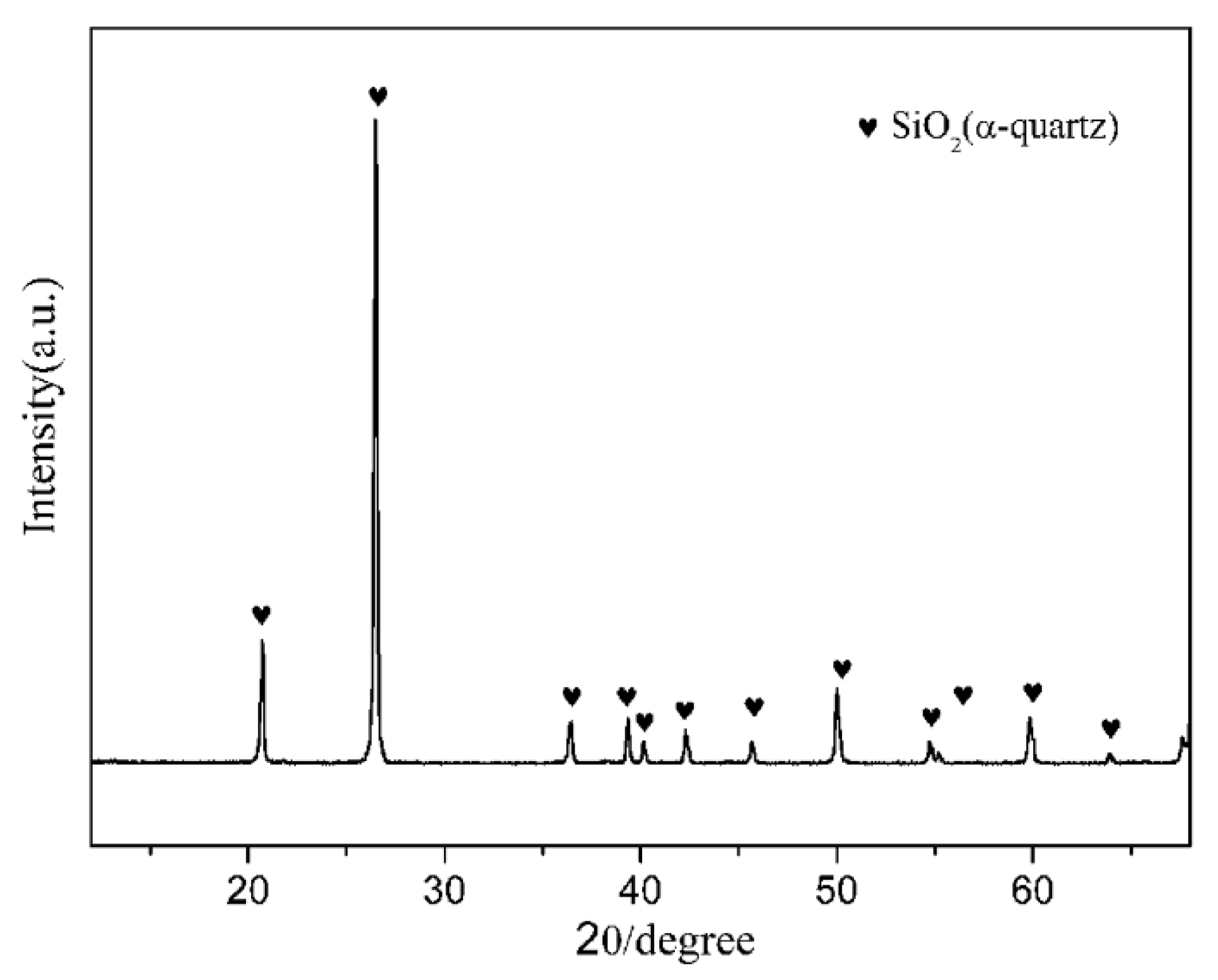
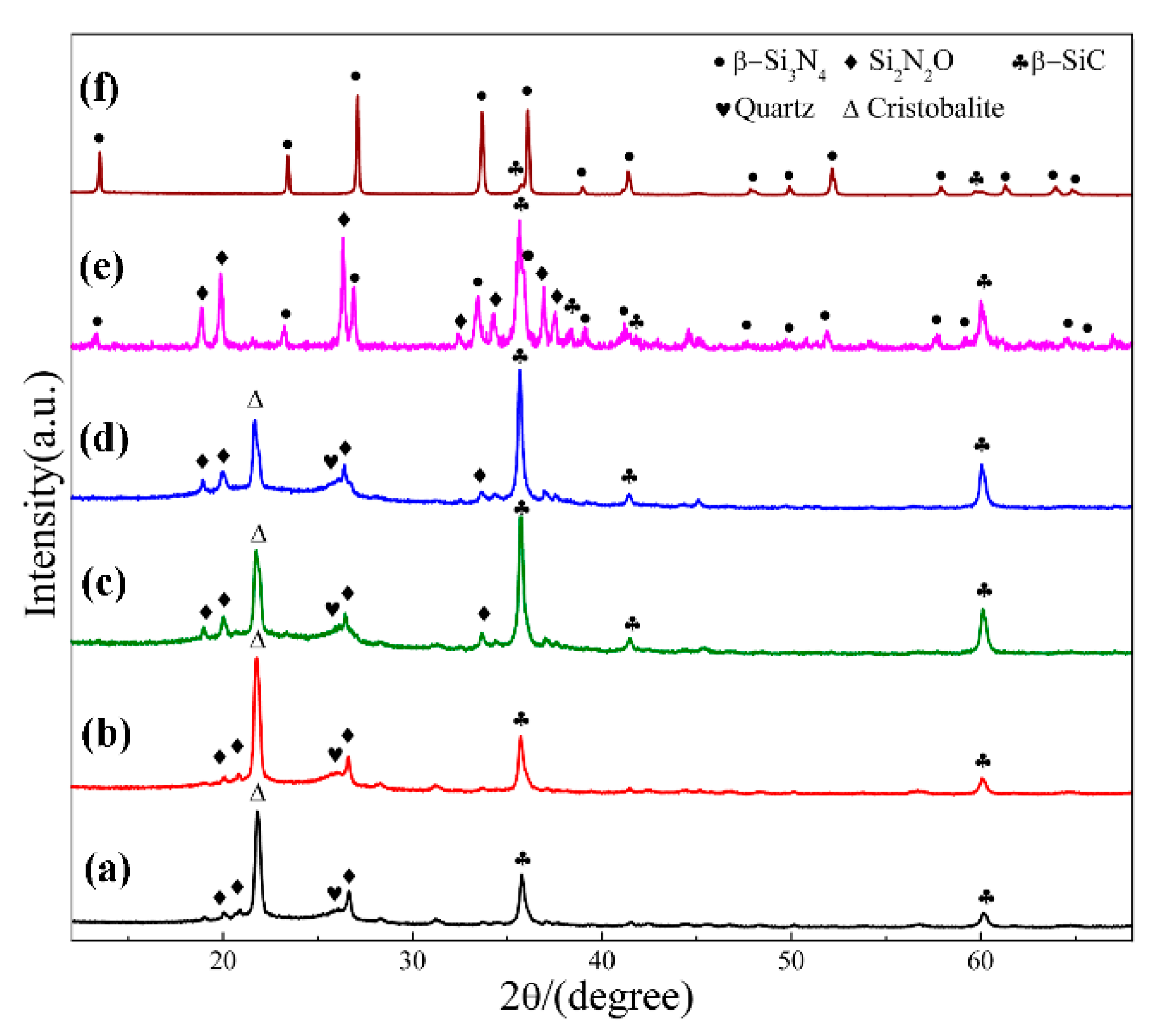
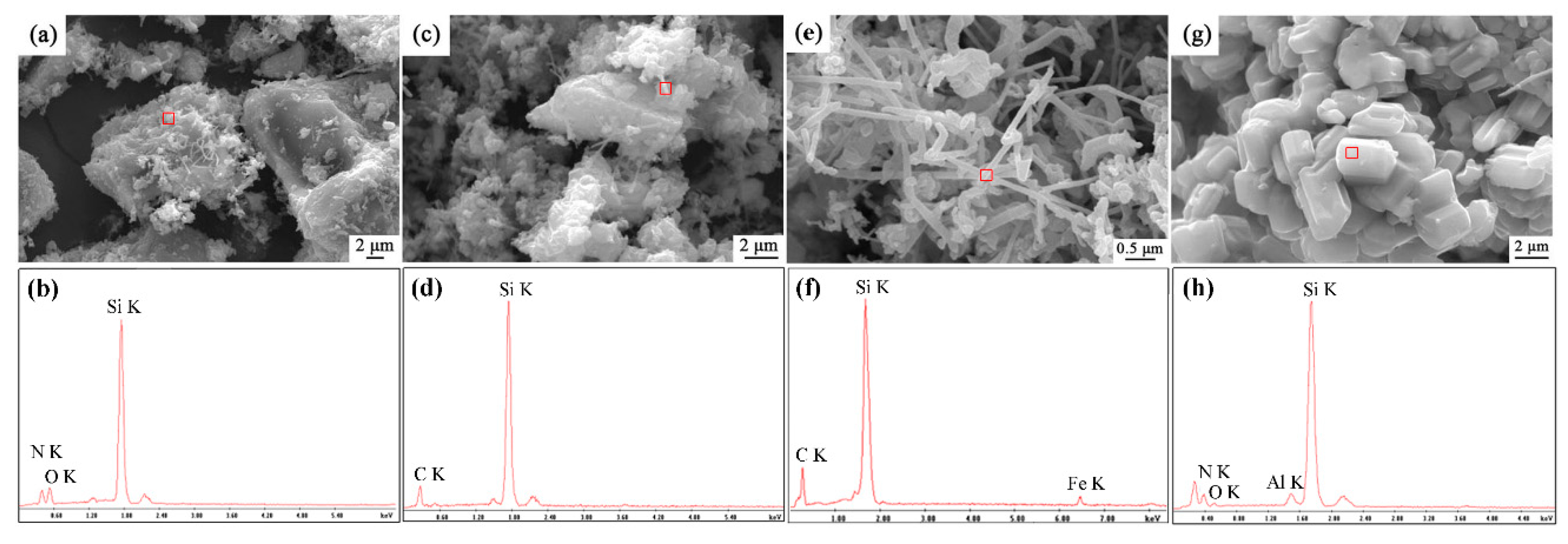
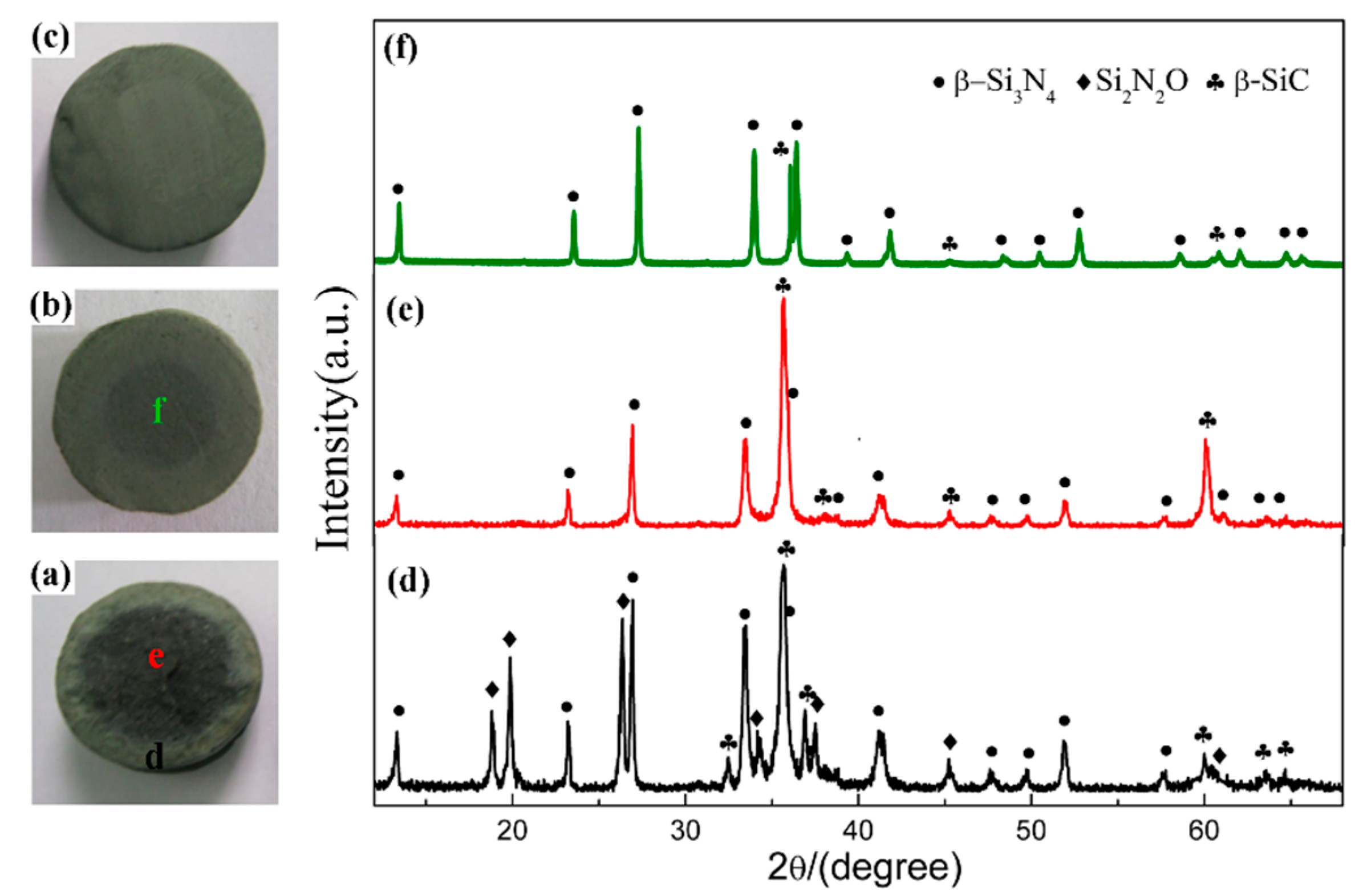
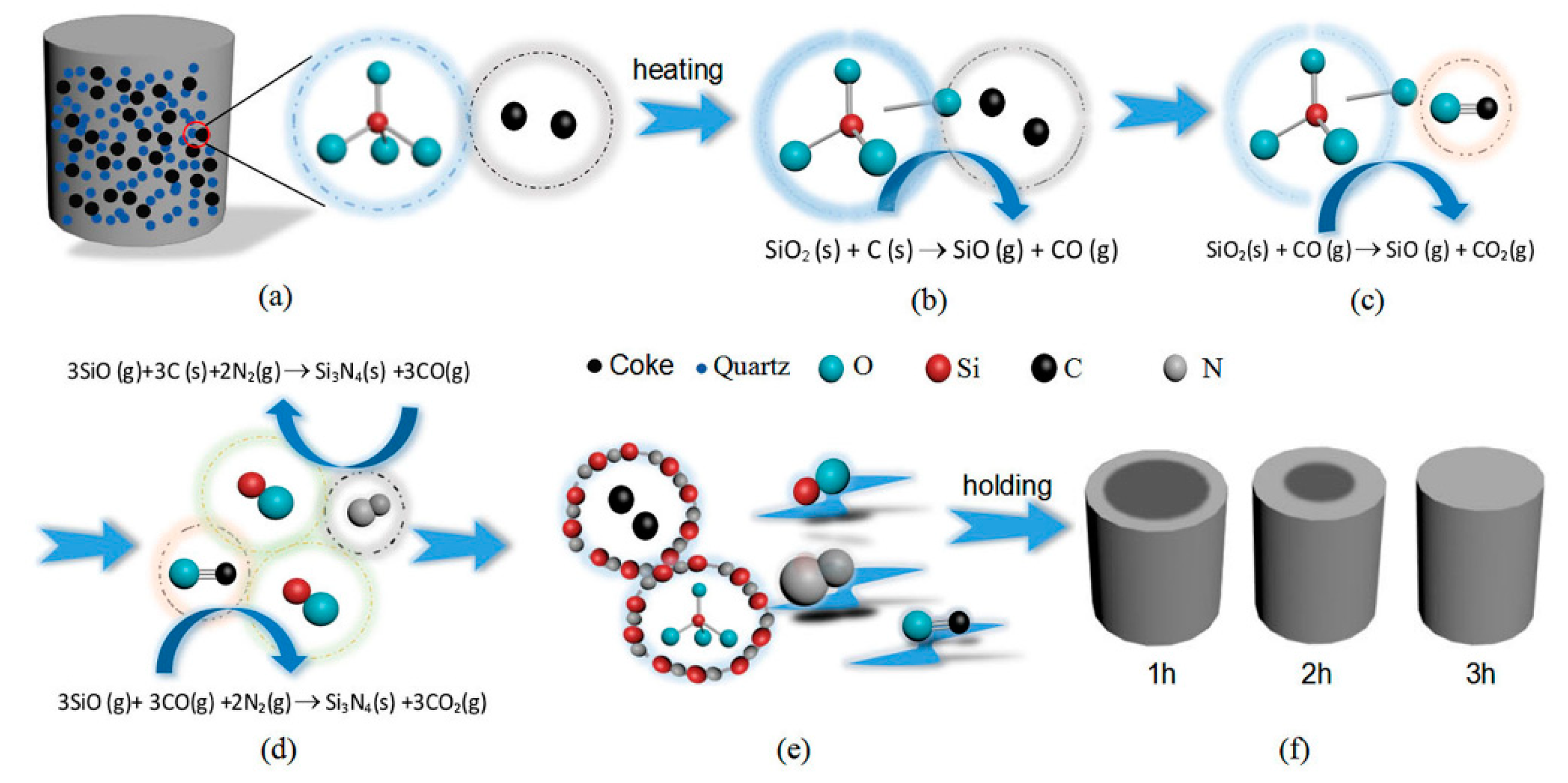
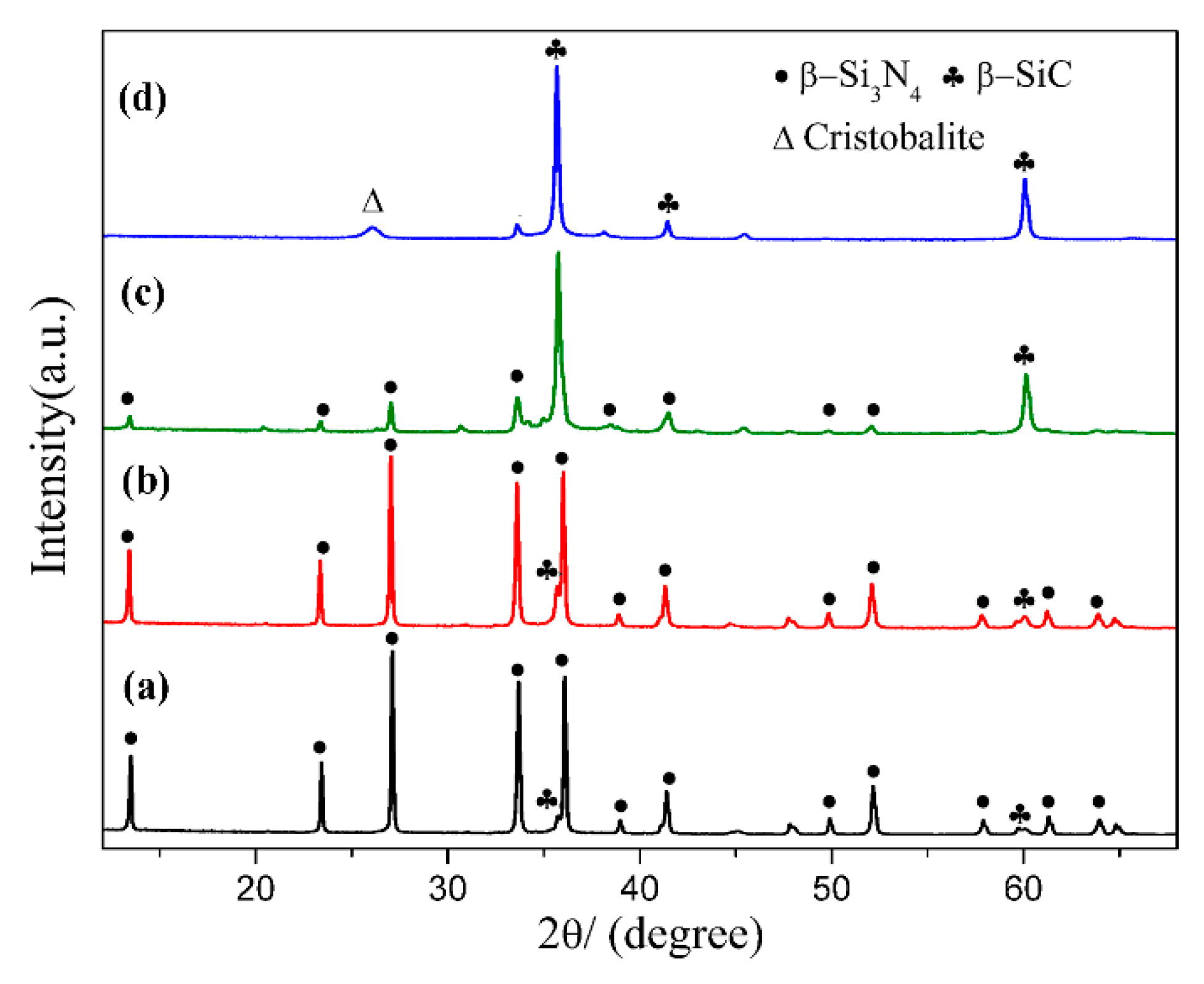
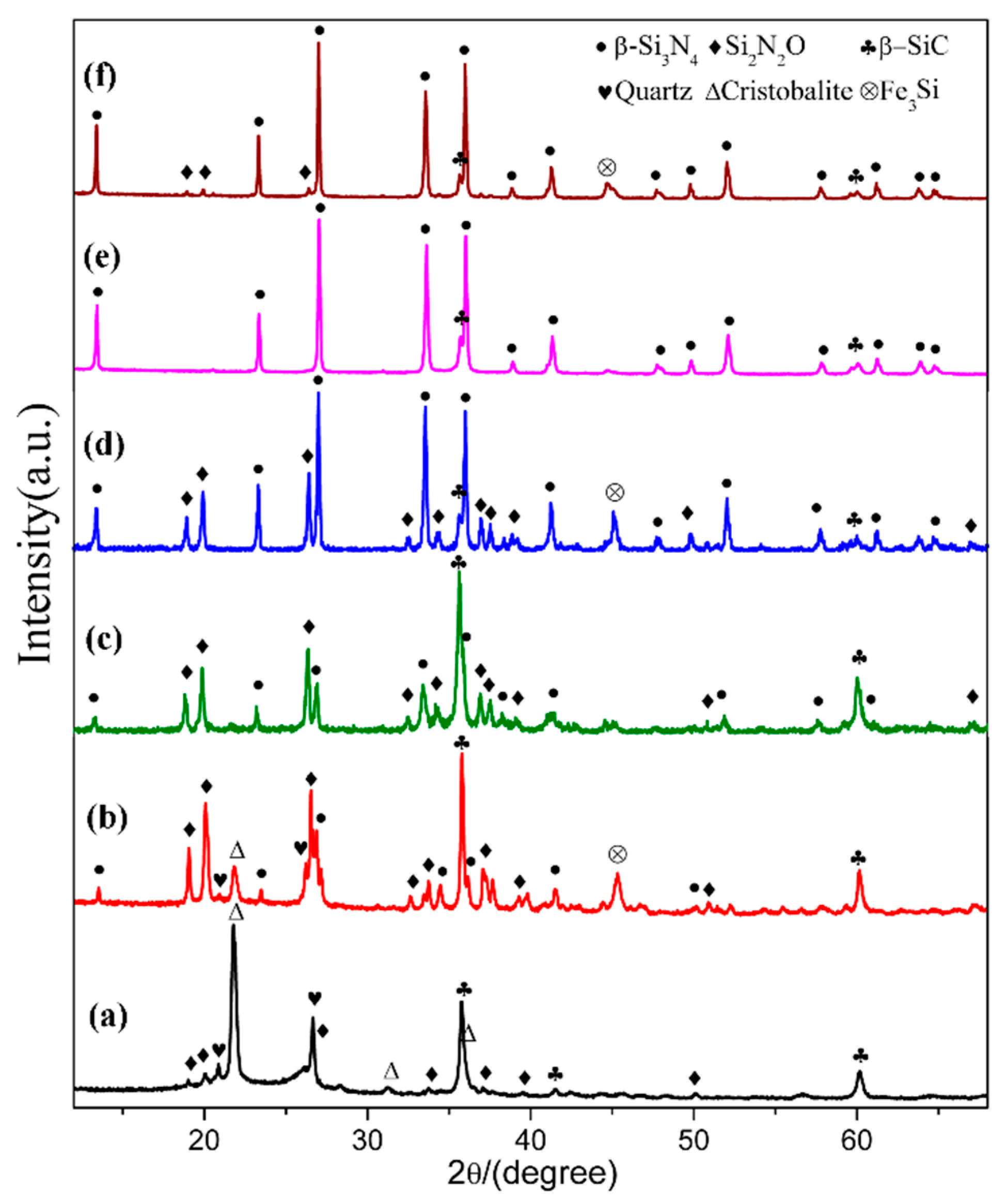
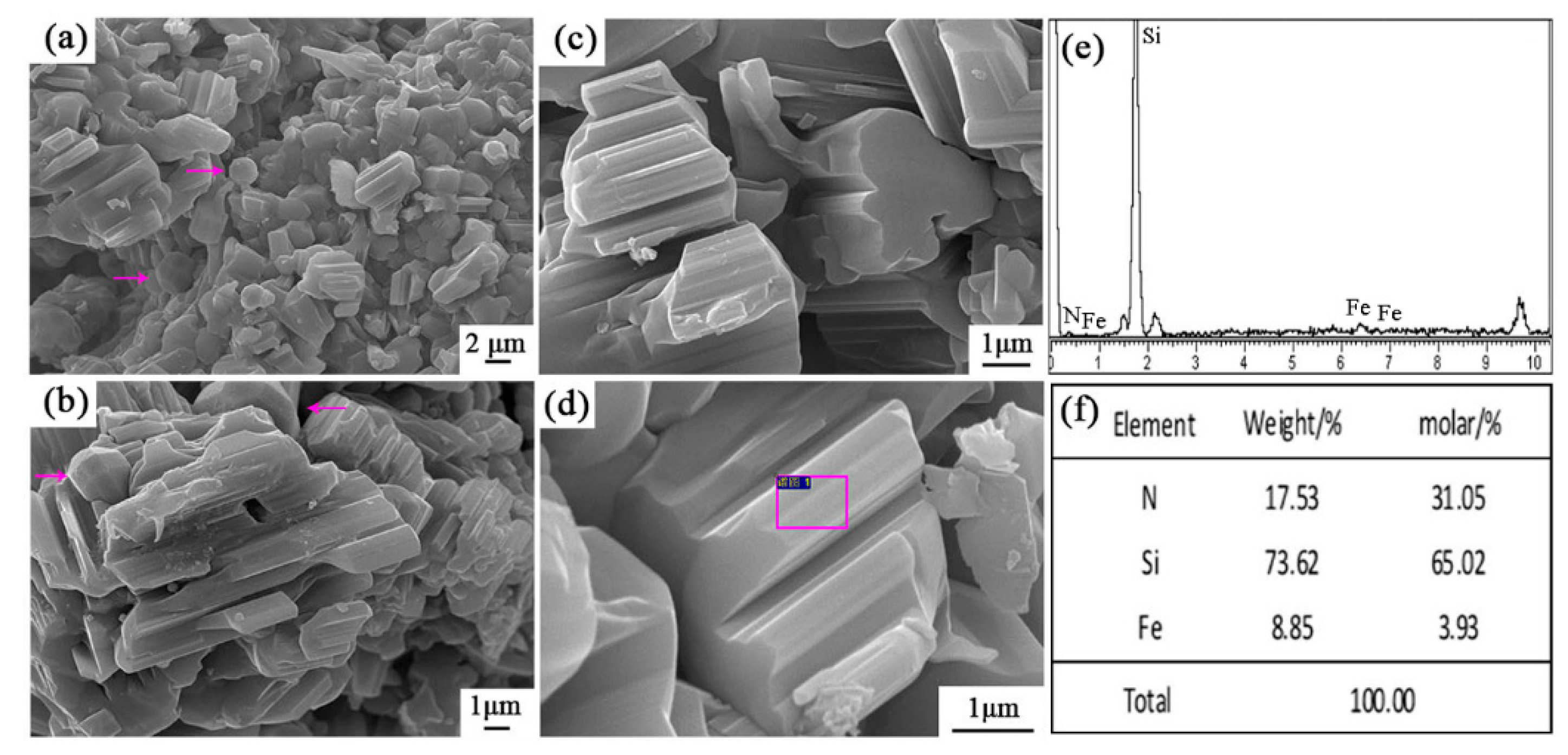
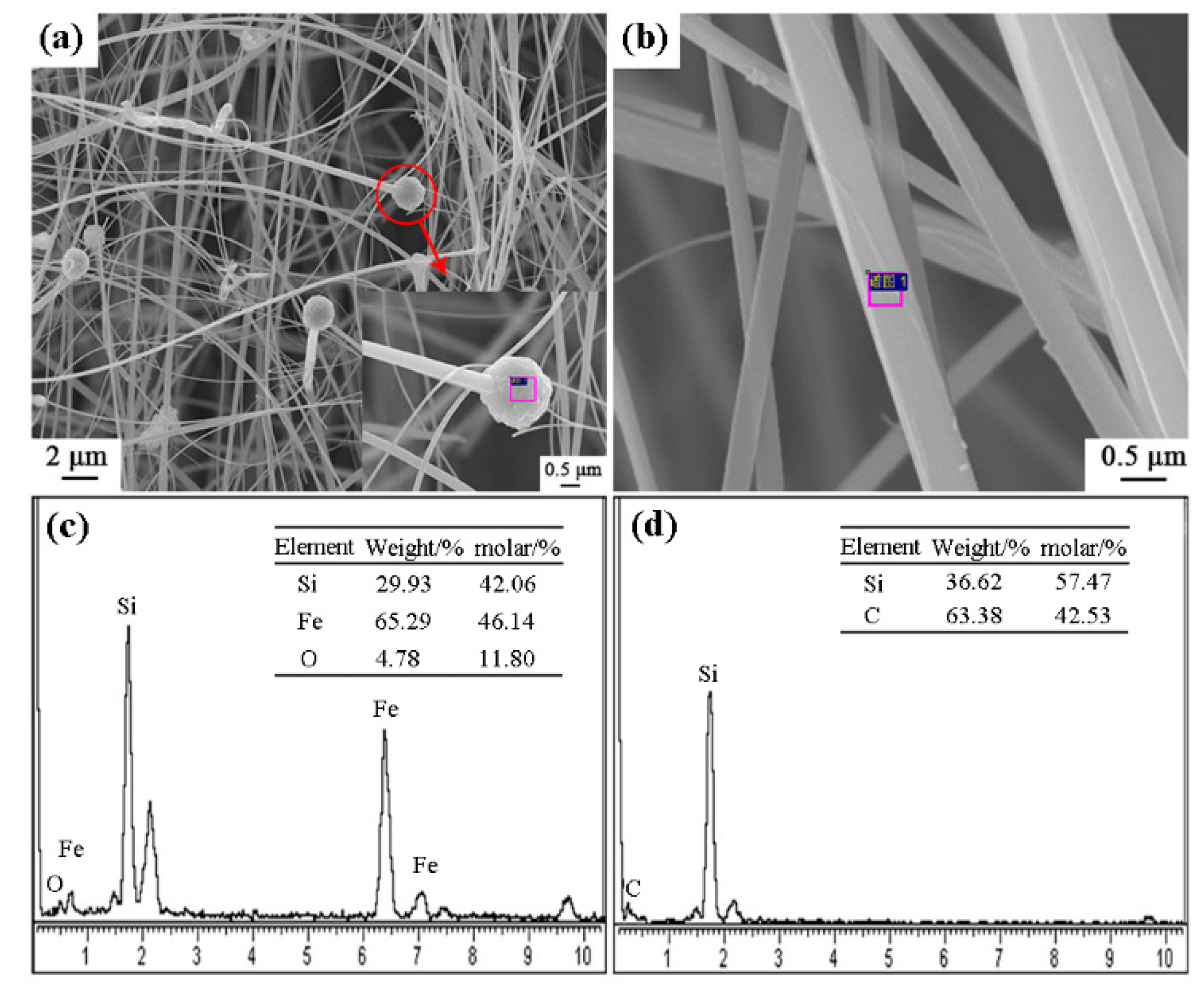
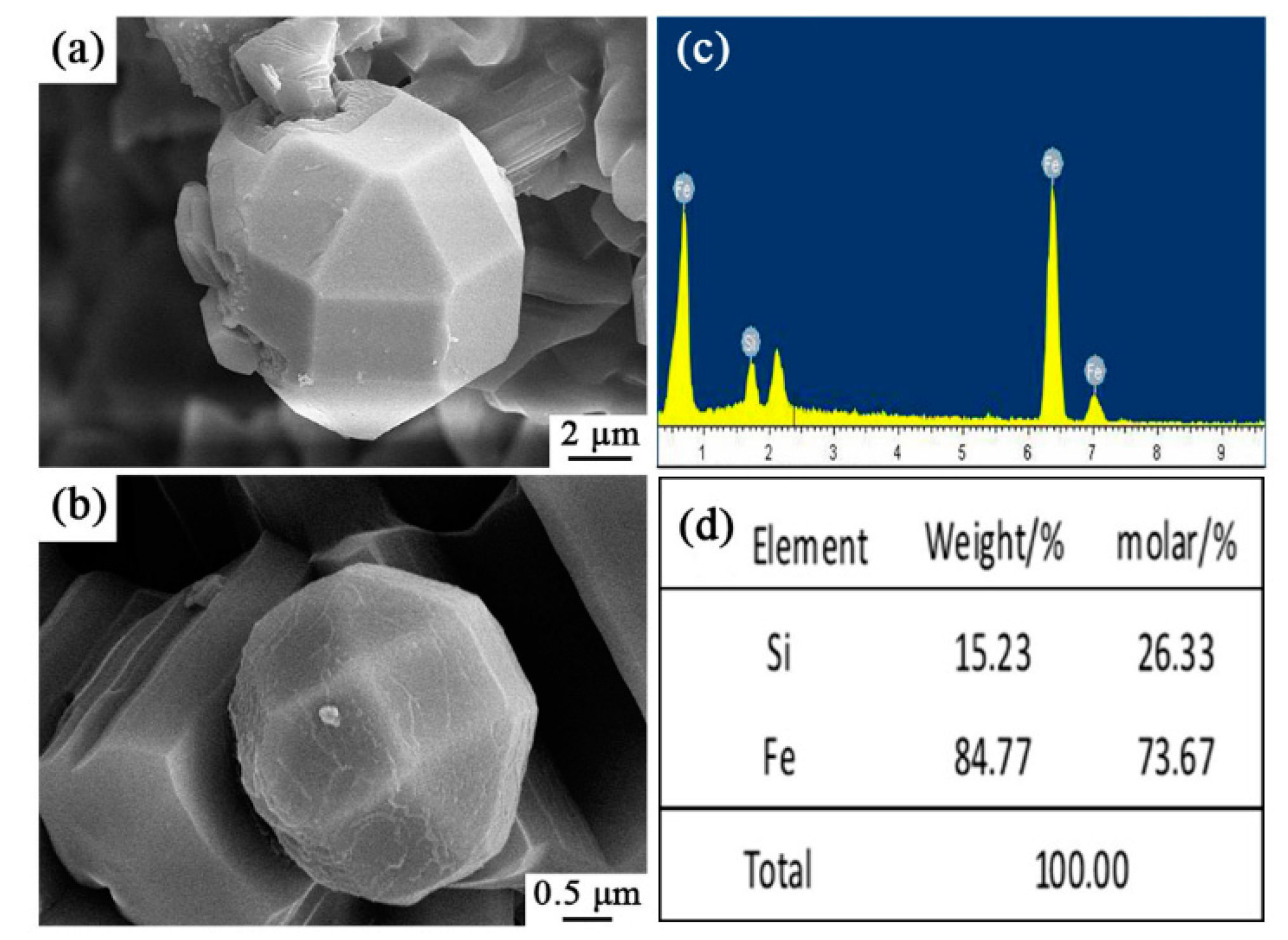
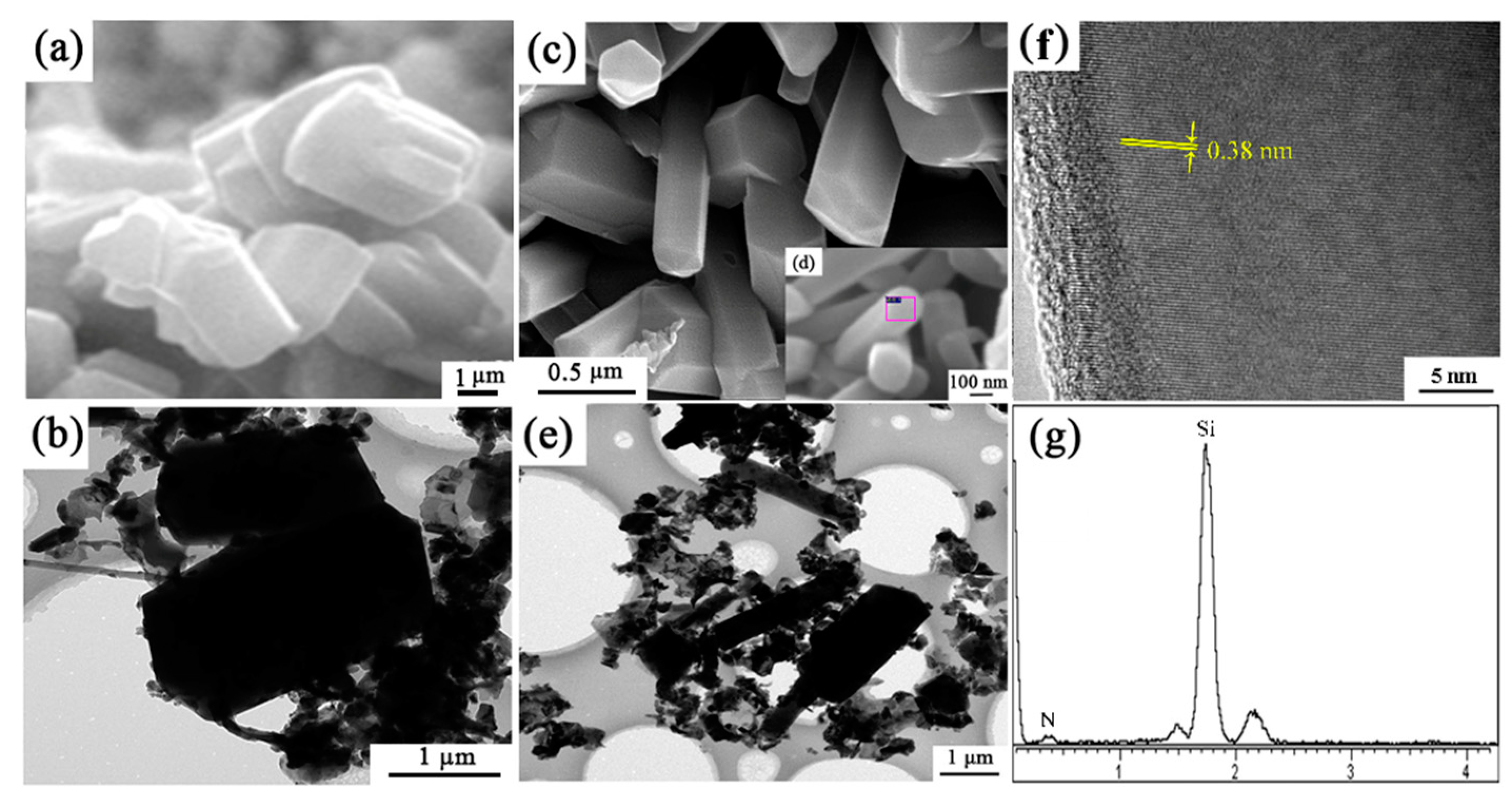
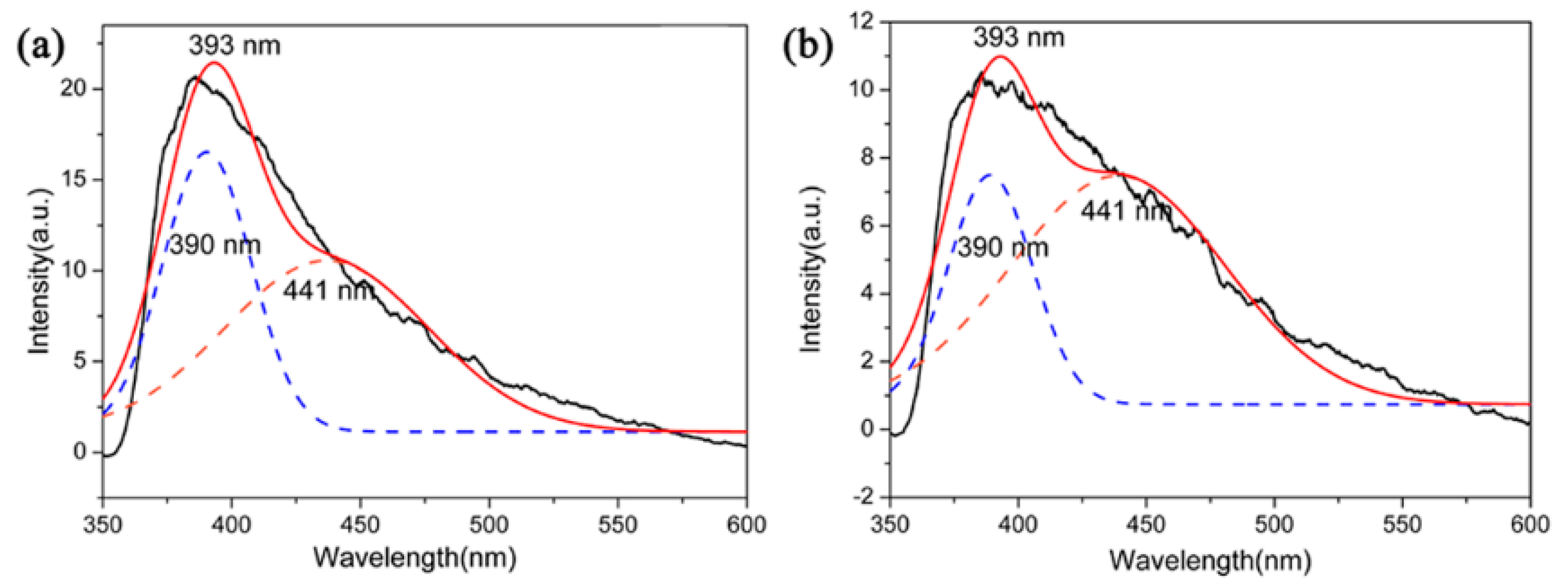
| Samples | C/SiO2 Molar Ratio | Coke | Quartz | Fe2O3 (Extra) | β-Si3N4 (Extra) |
|---|---|---|---|---|---|
| S1 | 2 | 30.77 | 69.23 | 0 | 0 |
| S2 | 2.2 | 32.84 | 67.16 | 0 | 0 |
| S3 | 3 | 40.00 | 60.00 | 0 | 0 |
| S4 | 4 | 47.06 | 52.94 | 0 | 0 |
| S5 | 2 | 30.77 | 69.23 | 4 | 0 |
| S6 | 2 | 30.77 | 69.23 | 0 | 2 |
| Samples | Littice Parameters | Cell Volume(Å3) | |
|---|---|---|---|
| a(Å) = b(Å) | c(Å) | ||
| S1, 1570 °C, Figures 2e and 7c | 7.6351 | 2.8867 | 145.7343 |
| S1, 1600 °C, Figures 2f and 7e | 7.8607 | 2.9139 | 155.9293 |
| S5, 1570 °C, Figure 7d | 7.7205 | 2.8695 | 148.1248 |
| S5, 1600 °C, Figure 7f | 7.7753 | 2.8993 | 151.7952 |
| Samples | β-Si3N4 | SiC | Si2N2O | Fe3Si |
|---|---|---|---|---|
| S1, 1570 °C, Figure 2e and Figure 7c | 32.20 | 36.06 | 31.74 | 0 |
| S1, 1600 °C, Figure 2f and Figure 7e | 91.52 | 8.48 | 0 | 0 |
| S5, 1570 °C, Figure 7d | 57.46 | 13.41 | 20.74 | 9.39 |
| S5, 1600 °C, Figure 7f | 85.47 | 6.85 | 4.22 | 3.46 |
| No. | Raw materials | Carbon Source | Additive | T/°C-t/h | Products | Reference |
|---|---|---|---|---|---|---|
| 1 | Amorphous SiO2 | carbon black | CaF2-1% | 1500-2 | β(42.8%) and α | [8] |
| 2 | Amorphous SiO2 | carbon black | CaF2-10% | 1500-2 | β(81.8%) and α | [8] |
| 3 | Amorphous SiO2 | carbon black | None | 1500-2 | β(52.4%) and α | [22] |
| 4 | Amorphous SiO2 | carbon black | CaF2, Y2O3 | 1500-2 | β(90%) and α | [22] |
| 5 | Amorphous SiO2 | carbon black | CaF2, Y2O3 | 1700-2 | β(100%) | [22] |
| 6 | Quartz powder | carbon black | Y2O3, Bentonite | 1450-3 | β(26.9%), α | [34] |
| 7 | Quartz powder | carbon black | Y2O3, Bentonite | 1500-3 | β(85.7%), α | [34] |
| 8 | Synthetic silica | activated charcoal | MgO or Y2O3 | 1375-3 | Si2N2O, β:α = 1:9 | [35] |
| 9 | Synthetic silica | activated charcoal | MgO or Y2O3 | 1475-3 | β:α = 1:2 | [35] |
| 10 | Quartz sand | activated charcoal | Fe(NO3)3 | 1300-3 | quartz, Si2N2O, β:α = 3:4 | [36] |
| 11 | Quartz sand | activated charcoal | Fe(NO3)3 | 1540-3 | β:α = 9:1 | [36] |
| 12 | Quartz | coke powders | None | 1470-3 | cristobalite, SiC and Si2N2O | This article |
| 13 | Quartz | coke powders | Fe2O3 | 1470-3 | SiC, Si2N2O, β, quartz | This article |
| 14 | Quartz | coke powders | None | 1600-3 | β(100%) | This article |
© 2019 by the authors. Licensee MDPI, Basel, Switzerland. This article is an open access article distributed under the terms and conditions of the Creative Commons Attribution (CC BY) license (http://creativecommons.org/licenses/by/4.0/).
Share and Cite
Zhang, M.; Chen, Z.; Huang, J.; Huang, S.; Hu, Z.; Feng, Z.; Xiong, Q.; Li, X. β-Si3N4 Microcrystals Prepared by Carbothermal Reduction-Nitridation of Quartz. Materials 2019, 12, 3622. https://doi.org/10.3390/ma12213622
Zhang M, Chen Z, Huang J, Huang S, Hu Z, Feng Z, Xiong Q, Li X. β-Si3N4 Microcrystals Prepared by Carbothermal Reduction-Nitridation of Quartz. Materials. 2019; 12(21):3622. https://doi.org/10.3390/ma12213622
Chicago/Turabian StyleZhang, Meng, Zhi Chen, Juntong Huang, Saifang Huang, Zhihui Hu, Zhijun Feng, Qingming Xiong, and Xibao Li. 2019. "β-Si3N4 Microcrystals Prepared by Carbothermal Reduction-Nitridation of Quartz" Materials 12, no. 21: 3622. https://doi.org/10.3390/ma12213622
APA StyleZhang, M., Chen, Z., Huang, J., Huang, S., Hu, Z., Feng, Z., Xiong, Q., & Li, X. (2019). β-Si3N4 Microcrystals Prepared by Carbothermal Reduction-Nitridation of Quartz. Materials, 12(21), 3622. https://doi.org/10.3390/ma12213622






